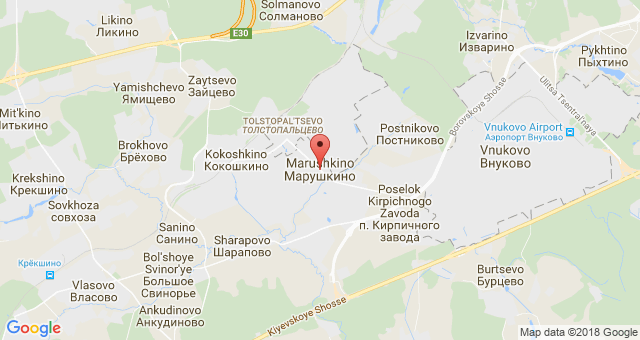Marushkinsky settlement is an administrative-territorial unit that is part of the Novomoskovsky district. It was established on 02.28.2005, until 2012 it belonged to the Naro-Fominsk municipal district. The number of inhabitants is approaching 7000 people.
Composition
15 settlements are included in the structure of the Marushkinskoye settlement:
- Villages: Sharapovo (30 inhabitants), Sokolovo (51), Postnikovo (157), Krekshino (63), Davydkovo (127), Vlasovo (78), Bolshoy Pigland (27), Bolshoy Pokrovskoye (145), Ankudinovo (6), Akinshino (155).
- Villages: Krekshino station (196), Kreshkino state farm (1460), Krasnye Gorki (61), Brick factory (12).
The administrative center is the village of Marushkino, where more than 2900 people live.
Location
The Marushkinsky settlement is located in the northwestern part of New Moscow, between the Kiev and Minsk highways, about 15 km from the Moscow Ring Road. In the east, it is adjacent to the Vnukovo airport.
Transport links are well developed, both automobile and railway. By road, you can reach the Garden Ring in 30 minutes, to Odintsovo and the village of Bolshie Vyazma in 20 minutes. Bus number 526 runs from the metro station Teply Stan to Marushkino.
A railway line with stations Tolstopaltsevo, Kokoshkino and Krekshino passes through the settlement. The Moscow-Kievskaya-Kokoshkino electric train passes the journey in 40 minutes, the cost of a full ticket is 88 rubles. (2018).
Geography
The territory of the Marushkinsky settlement in Moscow (and this is 50.6 km 2 ) is hilly, with heights of more than 200 m above sea level, cut by small rivers, streams and ravines. Among the largest water bodies are:
- R. Dunno;
- ruch. Aleshin;
- Krekshinsky pond;
- Lake Forest.
- Lake Sokolovo.
Significant areas are occupied by forest stands and parks. At the same time, the settlement is urbanized. Multi-storey residential districts alternate with the private sector and, in fact, represent a single development stretching to Old Moscow.
Historical reference
At the beginning of the 18th century, the Marushka settlement was known as the center of the bristle-brush industry. Here they made army, horse, head, boot, clothes brushes. At the beginning of the XIX century, gold lace industry arose.
By 1852, the population of the village of Marushkino reached 140 people, and the nearby estate of Sobakino - 57 people. The main occupations remained lace weaving, brush production and agriculture. To facilitate crafts in 1899, a training brush workshop was established. In 1914, the Moscow Regional Agricultural Station was established on local lands to study the local climate, soil, weed vegetation, livestock farming features, and agricultural farming technologies. After the revolution, MOSHOS continued its work. In the 1930s, the institution was reorganized into the zootechnical experimental station MOZOS.
The Marushkinsky settlement is the successor of the Marushkinsky Village Council, formed in 1919. In 1926, more than 1,600 people lived here. At first it belonged to Zvenigorod, and later it was transferred to the Naro-Fominsk district. In 1994, after the reform of local self-government, a rural district was created, transformed in 2005 into a rural settlement. On 1.07.2012, the administrative-territorial unit became part of New Moscow, while the definition of “rural” was abolished.
Economy
The production of the settlement Marushkinskoye (Moscow) is represented by small enterprises, cooperatives and individual entrepreneurs. In 2010, the volume of shipped products and services performed amounted to 185.5 million rubles. In 2013, this figure amounted to 217.5 million rubles.
The leading sector remains the agricultural sector. In 2013, 800 tons of grain crops, 1000 tons of potatoes, 1200 tons of vegetables were grown. The volume of meat production due to the expansion of the Elinar-Broiler poultry farm increased from 300 tons in 2010 to 500 tons in 2013. Dairy production remains at the level of 2900-3100 tons. Egg production is approximately 200,000 pieces.
The construction sector is expanding. Mainly due to the construction of new housing complexes, repair and construction of roads. The length of the paved web increased from 31.7 km (2010) to 38.6 km (2013). In the future, as the New Moscow development program is implemented, more than 50 km of roads will be paved.
sights
There are not many memorable places on the territory of the settlement. In Krekshino is the estate Chertkova. Colonel Krekshin at the end of the 18th century built a small country house in the village, around which he set up a park with wide linden alleys. Later, the property was transferred to Musina-Pushkina, and in the 1850s, Count Pashkov became the owner. In the 1880-1910s, Leo Tolstoy repeatedly visited here, who came to visit his friend Chertkov, a relative of the Pashkovs. After the revolution, the estate was converted into a hostel. The building gradually deteriorated, in 1996 all wooden structures were destroyed by fire.

On the site of another estate - the poet Kheraskov - is now a picturesque family park "Stream". It is located on the banks of the Alesha stream within the boundaries of the village of Marushkino. Previously, there was an old manor Sobakino. The green area is 14.5 ha. Sports facilities and playgrounds were built in the park, the cascade of ponds was restored, and a network of hiking trails was laid.